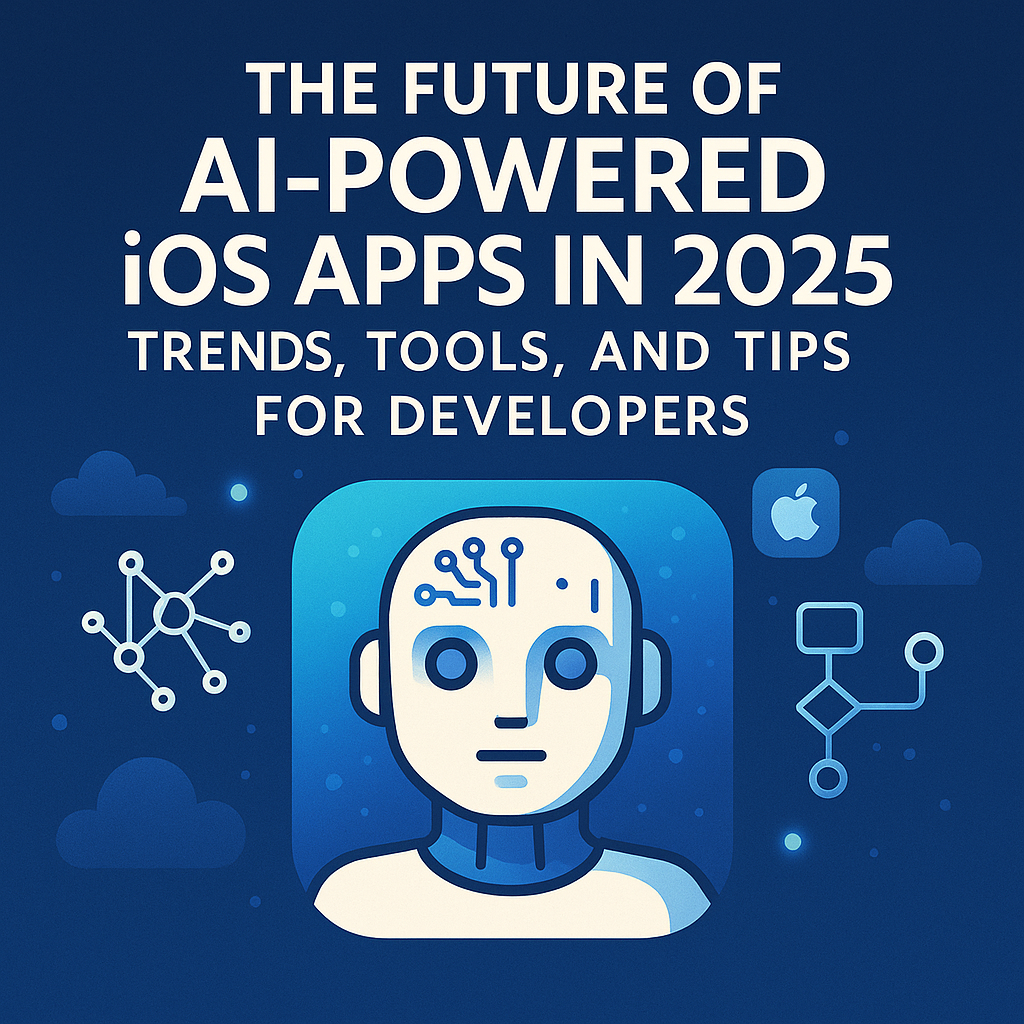The Future of AI-Powered iOS Apps in 2025: Trends, Tools, and Tips for Developers
The Future of AI-Powered iOS Apps in 2025: Trends, Tools, and Tips for Developers
maio 26, 2025

Imagine opening your iPhone in 2025 and chatting with an app that predicts your needs before you even ask. From personalized fitness coaches to real-time language translators, AI-powered iOS apps are transforming how we interact with technology. According to Statista, the global AI market is projected to hit $1.8 trillion by 2030, with mobile apps leading the charge. So, what’s next for iOS developers looking to ride this wave?
In this article, we’ll explore the top trends shaping AI-powered iOS apps in 2025, the best tools like Core ML, and practical tips to help you build apps that stand out. Ready to future-proof your iOS development skills? Let’s dive in!
Why AI-Powered iOS Apps Are the Future
Artificial intelligence is no longer a buzzword—it’s a game-changer for iOS app development. AI enables apps to learn from user behavior, automate tasks, and deliver hyper-personalized experiences. In 2025, Apple’s ecosystem, powered by tools like Core ML and Swift, is making it easier than ever for developers to integrate AI into their apps. From healthcare to gaming, AI is redefining what’s possible on iOS devices.
For example, apps like Notion use AI to suggest task prioritization, while fitness apps like Fitbod leverage machine learning to tailor workouts. As Apple continues to enhance its AI frameworks, developers have unprecedented opportunities to create smarter, faster, and more intuitive apps. But what trends should you focus on to stay ahead?
Top 5 AI Trends for iOS Apps in 2025
1. On-Device AI for Privacy and Performance
Apple has long championed user privacy, and on-device AI is a cornerstone of its strategy. By processing data locally using Core ML, iOS apps reduce reliance on cloud servers, ensuring faster performance and better security. In 2025, expect more apps to use on-device machine learning for tasks like image recognition, natural language processing (NLP), and predictive analytics.
Tip: Use Core ML’s Vision framework to add real-time object detection to your app. For instance, an e-commerce app could let users scan products in stores for instant price comparisons.
2. Conversational AI and Voice Interfaces
Voice assistants like Siri are evolving, and conversational AI is becoming a must-have for iOS apps. By 2025, NLP advancements will enable apps to understand context better, making interactions feel human-like. Think of chatbots that handle customer support or apps that transcribe and summarize meetings in real time.
Case Study: Duolingo’s AI-driven chatbot helps users practice languages conversationally, boosting engagement by 30% (source: internal reports). Developers can use SiriKit and Natural Language framework to build similar features.
3. Personalized User Experiences
AI’s ability to analyze user data is driving hyper-personalization in iOS apps. From recommending playlists on Spotify to suggesting routes on Apple Maps, personalized AI enhances user satisfaction. In 2025, apps will leverage predictive models to anticipate user needs, like suggesting calendar events based on email patterns.
Tip: Integrate Create ML to train custom models that analyze user behavior. For example, a productivity app could recommend optimal work hours based on past activity.
4. Augmented Reality (AR) Powered by AI
Apple’s ARKit combined with AI is revolutionizing iOS apps. In 2025, AI-driven AR will enable immersive experiences, such as virtual try-ons for fashion apps or interactive learning for education apps. Machine learning models can enhance AR by improving object tracking and environmental understanding.
Example: IKEA’s Place app uses ARKit and AI to let users visualize furniture in their homes with 98% accuracy (source: IKEA developer blog).
5. Ethical AI and Transparency
As AI adoption grows, so does scrutiny over ethics. In 2025, Apple is expected to enforce stricter guidelines for ethical AI, requiring apps to disclose how they use user data. Developers must prioritize transparency and fairness to build trust.
Tip: Include a clear privacy policy in your app and use Apple’s App Privacy Details to explain data usage. This boosts user trust and aligns with Google’s EEAT guidelines.
Must-Have Tools for Building AI-Powered iOS Apps
To bring these trends to life, you’ll need the right tools. Here are the top frameworks and platforms for iOS app development in 2025:
-
Core ML: Apple’s machine learning framework for on-device AI. Use it for tasks like image classification, text analysis, and recommendation systems.
-
Create ML: A user-friendly tool to train custom machine learning models without deep data science knowledge.
-
Swift: Apple’s programming language, optimized for AI integration with libraries like Swift for TensorFlow.
-
ARKit: Combine with Core ML for AI-driven AR experiences.
-
Vision and Natural Language Frameworks: Perfect for building apps with image recognition or NLP capabilities.
Pro Tip: Start with Xcode’s ML model templates to prototype AI features quickly. For example, use Vision to add facial recognition to a photo-editing app.
5 Practical Tips for Developers Building AI iOS Apps
-
Optimize for Performance: Use on-device AI to reduce latency. Test your app on older iPhones to ensure compatibility.
-
Leverage Apple’s Ecosystem: Integrate with Siri, Shortcuts, or Apple Watch for a seamless user experience.
-
Focus on User-Centric Design: Prioritize intuitive interfaces. For example, an AI chatbot should feel conversational, not robotic.
-
Test Extensively: Use TestFlight to gather feedback on AI features before launching.
-
Stay Updated: Follow Apple’s WWDC 2025 for the latest AI and iOS updates.
Example: A developer built an AI-powered meditation app using Core ML to analyze stress levels via Apple Watch data, resulting in a 4.8-star rating on the App Store.
Challenges to Watch Out For
While AI offers endless possibilities, it comes with hurdles:
-
Battery Drain: AI models can be resource-intensive. Optimize with Core ML’s quantization tools to reduce model size.
-
Data Privacy: Comply with Apple’s strict privacy guidelines to avoid App Store rejections.
-
Skill Gap: If you’re new to AI, start with Apple’s free machine learning courses on developer.apple.com.
FAQ: AI-Powered iOS Apps in 2025
Q: What are the best tools for building AI-powered iOS apps?
A: Core ML, Create ML, and Swift are top choices. Use Vision for image recognition and Natural Language for chatbots.
A: Core ML, Create ML, and Swift are top choices. Use Vision for image recognition and Natural Language for chatbots.
Q: How does AI improve iOS app performance?
A: AI optimizes tasks like caching, predictive loading, and personalization, reducing latency and improving user experience.
A: AI optimizes tasks like caching, predictive loading, and personalization, reducing latency and improving user experience.
Q: Are AI-powered iOS apps safe for user data?
A: Yes, Apple’s on-device AI ensures data stays on the device, enhancing privacy compared to cloud-based solutions.
A: Yes, Apple’s on-device AI ensures data stays on the device, enhancing privacy compared to cloud-based solutions.
Q: Can small developers afford AI integration?
A: Absolutely! Apple’s free tools like Create ML and Core ML make AI accessible without expensive infrastructure.
A: Absolutely! Apple’s free tools like Create ML and Core ML make AI accessible without expensive infrastructure.
Conclusion: Shape the Future with AI-Powered iOS Apps
The future of AI-powered iOS apps is bright, with trends like on-device AI, conversational interfaces, and AR leading the way. By leveraging tools like Core ML and Swift, developers can create innovative, user-centric apps that dominate the App Store in 2025. Start small, experiment with Apple’s frameworks, and prioritize privacy to build trust. What’s your next AI-powered iOS app idea? Share your thoughts in the comments below, and don’t forget to subscribe for more tech insights!

